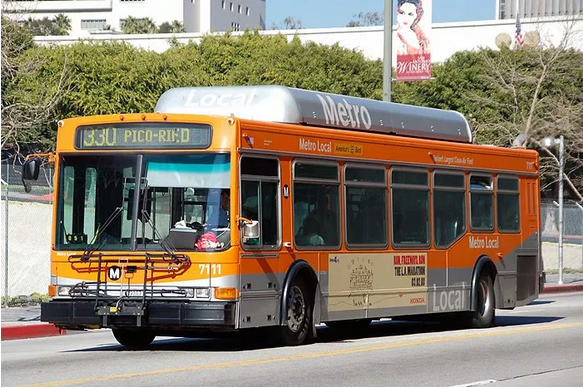Last week the Metro board approved the agency's $7.2 billion FY2020 budget.
On the expenditure side, Metro approved $2 billion for building transit. Nearly all of this is for rail; this includes the already-under-construction Westside Purple extensions 1-2-3, Regional Connector, Foothill Gold Line phase 2B, and Crenshaw/LAX line with its airport connection. There is also funding for planning for a dozen additional lines (mostly rail, with a couple of Bus Rapid Transit), as well as Orange Line improvements and Express Lanes for the 405 and 105. The budget includes $320 million for widening and otherwise expanding the county's freeways.
On the income side, the budget is dominated by sales tax revenue, including $3.5 billion ($873 million each) from Measures A, C, R, and M. In comparison, transit fare revenue accounts for only $284 million.
The most discussed portion of the budget has been transit operations.
When SBLA first looked into Metro's FY2020 budget, it included cuts to both bus and rail service. Metro subsequently slightly upped its bus service budget - increasing bus service hours from 7,019,376 to 7,094,376. That increase means that, for a leap year, FY2020 budgeted bus service hours per day remain level with FY2019.
A small silver lining for bus riders is an increase in Metro's funding of municipal operators, including Foothill Transit, Big Blue Bus, etc. The FY2020 budget increases the municipal operators' allocation from $428.5 million to $473.1 million, a 10.4 percent increase. This is a balancing act, though, as most municipal operators serve suburban parts of the county, while Metro serves more of the urban core.
If trends hold - i.e.: if car traffic increases keep leading to bus speed decreases - keeping service hours the same means that Metro's bus riders will experience only a minor erosion of bus service.
The final approved budget still includes cuts to rail service, decreasing annual service hours by 5.7 percent - from 1,203,231 to 1,134,953. This includes cuts to weekday and weekend service:
- Blue Line peak hour weekday service cut - headways increase from 6 to 8 minutes
- Expo Line peak hour weekday service cut - headways increase from 6 to 8 minutes
- Gold Line peak hour weekday service cut - headways increase from 7 to 8 minutes
- Weekend rail peak service cut - 12 minute headways that used to start at 8 a.m. will not start until 10 a.m.
These cuts are expected to go into effect on June 23.
In recent board meetings, Metro operations management tried to put a good spin on these cuts, claiming that they are right-sizing rail service to match declining ridership. They stressed that Metro will run all three-car trains at peak hours and will stop running short Blue Line trains that turn around at Willow, instead running them from end to end. Weekend cuts were justified to allow for maintenance, to impact the fewest amount of riders.
In a letter critiquing the FY2020 budget, Move L.A. points out that bus service has declined at a time when Metro revenue, including bus operations revenue, has increased. Per Move L.A. figures, comparing 2008 through 2020, Metro budgeted bus operations revenue grew from ~$890 million to ~$1,200 million, while service hours declined from 7.8 million to 7.1 million.
Move L.A. points out that during this time several new revenue streams became available for Metro transit operations. Most prominent among these are Measures R and M county sales taxes, which included 20 and 25 percent for transit operations. Additionally, Metro received operations funding from California's Low Carbon Transit Operations Program - LCTOP (cap-and-trade greenhouse gas reduction funding) and S.B. 1 (state gas tax). In addition to those, Metro raised fares in 2010 and 2014.
Metro's budget allocates only $1.84 billion on overall transit operations and maintenance, even though it has operations-eligible revenue (mostly sales funding) of $2.04 billion.
On top of that $2 billion, fare revenue ($284 million) and advertising revenue ($25 million) could also be used for transit operations.
Overall the budget prioritizes building new projects while shedding existing riders.
Why?
Some factors are out of Metro's control.
Federal transit funding has been delayed and reduced. L.A. County construction costs are overheated, partially attributable to other factors, including a tight labor market and new federal tariffs on Chinese goods.
But some factors are within Metro's control.
It is perhaps not news that elected leadership want to see plenty of shiny new infrastructure projects with opportunities for ribbon-cuttings. The push for project acceleration for the 2028 Olympics exacerbates this imbalance.
One wildcard is Metro's NextGen Bus Study, which is scheduled to conclude in late 2019 - with recommendations that might take effect in mid-2020. Operations staff were quick to point to transit service improvements coming soon as a result of this study. Perhaps allowing transit service to degrade slightly now will make the reorganization improvements appear better in comparison. In the meantime, riders will endure longer wait times and Metro ridership is likely to further decline.
Overall, Metro's budget ensures that the agency will miss out on opportunities to improve transit service - and to increase ridership - right now.
Move L.A. recommendations include an across-the-board fare reduction from $1.75 to $1.50, and further subsidizing student/senior/disabled passes. Other low-cost improvements could include expanding all-door boarding and enforcing of existing bus-only lanes. But transit riders shouldn't expect any of these this fiscal year.






